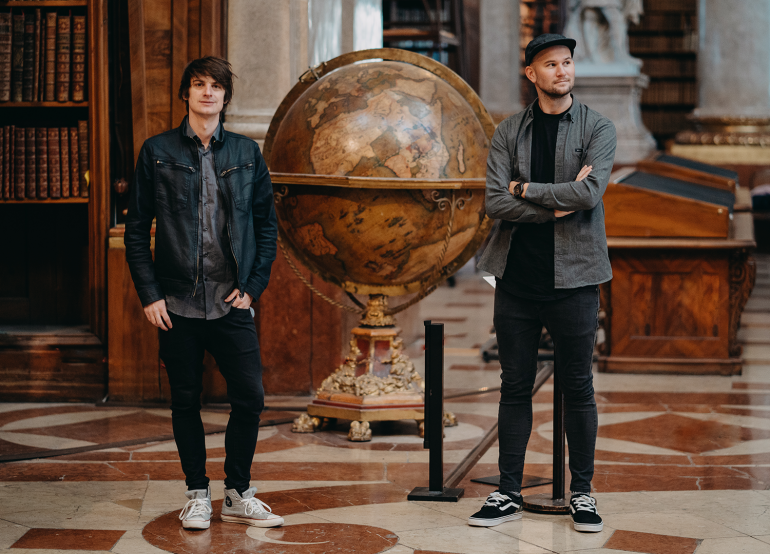The Viennese DnB legends Camo & Krooked are undoubtedly two very heavy hitters. Their sound is HUGE. Their live shows are exhilarating, and they still manage to keep an eye on the detail.
With audiences around the world and upcoming releases via the UK, these guys have managed to set their own standards in production and sonic quality. We love what they do, and we love the fact that they are humble as hell. So enjoy the interview, and get ready for some pretty great production advice:
First of all –congrats to your stunning releases. You’re a seasoned producing team, with a very sophisticated, very signature sound. How did you develop your aesthetic?
We are now making music for about 15 Years and we are still defining our own sound with each release and try to push the boundaries. Our idea is to integrate influences from very different genres into our sound, which is mostly produced on D&B tempo, 175bpm. We are big fans of Stephan Bodzin, Flume and Jon Hopkins, who manage to make their very underground sound so appealing that it works on all levels, very emotional, inventive and yet catchy. That are the attributes we thrive for as well.
Do you have a production routine or ritual? Please elaborate, juicydetails welcome!
We have two separate studios with the exact same setup. The Tune mostly starts at Markus end with the first drafts, which we then share and see who can evolve it into something that really catches our interest. Sometimes we work on different aspects of the tune, like Reini does the arrangement and Markus adds a hook on top, and sometimes on the same and compeed for the better outcome, on which we both work further then again to do the same, stepping up the ladder to the best possible outcome. Or to scrap the whole idea in the end!
Do you like collaborating with others? How would you describe the perfect form of musical collaboration?
We really like to collaborate with other artists, while it is a bit tough to collaborate with everyone sitting in one studio, having to wait for their turns. The perfect collaboration is with an artist who provides something you cant produce, like a great soulful vocal or a very organic instrument. You can’t process those things afterwards in your digital ways and give it your signature.
When you look back at your first release – what has changed the most in the way you produce and release music?
We used to produce, finish and release a lot of music, getting done one tune per month at least. Nowadays we kind of get stuck in ideas, wanting it to be perfect. The level we have set for ourselves is so high that a lot of times we break on it, but that’s the only way to evolve. We used to use a lot of samples when we began, nowadays we make most elements including drums with synthesizer, as that gives you the best possible control over the shape, texture and melody of a sound.
What are the biggest challenges you face as artists in the digital age?
Cutting through the noise of thousands of releases everyday has become very hard, especially for new artists that haven’t built a dedicated fanbase yet. All the infos about productions are at your fingertips with tutorials on YouTube but finding your own style gets hard, as there are so many producers trying to find their spot in the game.
Your live performances are pretty high-energy – do you have some insights on running a smooth live show? Please share them with us!
DJ performance and Live shows including a lot of different analogue equipment are two very different things. DJ Sets run pretty smooth and we are very confident about them. Live shows can get tricky and you keep troubleshooting until the very last moment before the show, but somehow you always find a way to make all the connections work and at least act on stage as everything would have been really smooth 😉
Some secret stuff – can you name three software plug-ins that you wouldn’t want to live without? Tell us why you love them.
We just discovered the Gullfoss Intelligent EQ plugin, which helps a lot to get a great sonic spectrum on the overall mix and on single tracks. Serum is a very tight synthesizer, very popular, as you can recreate a lot of different textures with a nice workflow. Overall we can really recommend Bitwig as a DAW as it has so many great internal VSTs and a intuitive workflow. You can make very complex routings very easily and it hardly ever crashes. Favorite program ever!
Your visuals are always very on point. Do you have some pointers oncreating and deciding upon stunning music artwork?
Having good conversations with your visual producer and giving him honest feedback and loads of references to make sure the product is as desired, that’s the key.
Name 3 mistakes you made in your career that other musicians could learn from.
- Overthinking everything too much, rather just go with the flow and get things done.
- Reading youtube comments, its straight up aids sometimes.
- Comparing yourself to others all the time, you are unique, and you don’t have to be the best at everything.
Follow Camo & Krooked:
Instagram
Spotify
SoundCloud
YouTube
Facebook
Twitter

